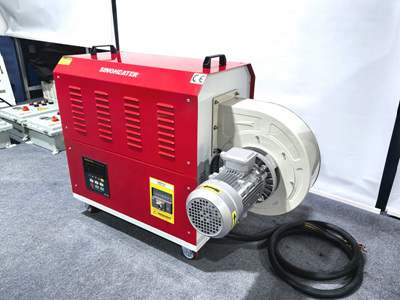In winter or low-temperature environments, pipeline freezing may cause disruptions in water supply, heating or industrial processes. Hot air blowers are commonly used defrosting tools. However, if not operated properly, it may cause safety accidents or damage the equipment. The following are detailed precautions regarding safety, efficiency and equipment maintenance:
First, safety operation norms
Prevent electric shock and leakage
Power check: Before use, make sure the power cord is undamaged and the plug matches the socket (it is recommended to use an industrial socket of 16A or above).
Grounding protection: Ensure that the hot air blower is well grounded to prevent electric leakage and electric shock (especially in a humid environment).
Waterproof isolation: It is strictly prohibited to place the hot air blower directly on ground with accumulated water or dampness. It should be raised or supported by a waterproof bracket.
Fire prevention and explosion prevention
Keep away from flammable materials: The outlet of the hot air blower should be at least 50cm away from pipes and insulation materials to prevent ignition caused by high temperatures.
No covering: It is strictly prohibited to cover the hot air blower with clothes, plastic sheets, etc., to prevent heat accumulation and fire.
Gas monitoring: If the gas pipeline is thawed, leakage should be detected in advance (such as with soapy water), and good ventilation should be ensured.
Personnel protection
Wear protective equipment: Operators should wear heat-resistant gloves, goggles and anti-scald work clothes to avoid scalding from hot air or high-temperature components.
Avoid direct blowing: The temperature at the outlet of the hot air blower can reach 300-500℃. It is strictly forbidden to blow air directly on the human body or skin.
Second, equipment usage skills
Temperature and air volume control
Stepwise heating: In the initial stage, preheat at a low temperature setting (such as 80-120℃). After the pipe surface thaws, gradually increase the temperature to 150-200℃.
Air volume regulation: Adjust the air volume according to the pipe diameter (for example, use a low air velocity for small-diameter pipes and a high air velocity for large-diameter pipes) to ensure uniform heat distribution.
Avoid local overheating: For plastic or composite pipes, the temperature should not exceed the material’s heat resistance limit (e.g., PVC pipes ≤60℃).
Thawing time and distance
Time estimation: The thawing time for each meter of pipe is approximately 10 to 20 minutes (adjusted according to the ambient temperature, pipe diameter and freezing degree).
Mobile heating: A “serpentine” mobile hot air blower is adopted to prevent pipe deformation caused by long-term fixed heating at the same position.
Distance optimization: Keep the hot air blower 15 to 30cm away from the pipeline. If it is too close, the pipeline may be burned out; if it is too far, the efficiency will decrease.
Post-thawing processing
Slow pressure recovery: After thawing, gradually open the valve to prevent sudden pressure changes from causing pipe rupture.
Check for leakage: Conduct a pressure test on the thawed pipeline (such as maintaining a pressure of 0.6MPa for 30 minutes) to ensure there is no leakage.
Thermal insulation and protection: After thawing, wrap the insulation material in time to prevent secondary freezing.
Third, equipment maintenance and upkeep
Daily inspection
Clean the air duct: After each use, clean the air inlet filter screen to prevent dust from clogging and affecting the air volume.
Check components: Inspect the heating wire, temperature control probe and fan blades monthly to ensure they are not loose or damaged.
Lubrication and maintenance: Regularly apply lubricating oil to moving parts (such as brackets and rollers) to reduce wear.
Long-term storage
Moisture-proof and dust-proof: Store in a dry and well-ventilated place and cover the hot air blower with a dust cover.
Power-off preservation: Unplug the power supply when not in use for a long time to prevent component aging.
Fault handling
Abnormal temperature: If the outlet air temperature is too high or too low, check whether the temperature controller and the heating wire are damaged.
Insufficient air volume: Clean the air duct or replace the fan motor to avoid a decrease in defrosting efficiency due to insufficient air volume.
Fourth, precautions for typical scenarios
Thawing of household water supply pipes
Tip: Defrost the easily frozen parts such as elbows and valves first. Use a low-temperature setting and wrap the pipes with a towel to reduce heat loss.
Taboo: It is strictly prohibited to directly heat the pipes with open flames to avoid causing fires or pipe bursts.
Thawing of industrial steam pipelines
Tip: Before thawing, close the steam valve and release the excess pressure. After thawing, slowly increase the temperature to the working pressure to prevent thermal stress damage.
Monitoring: Use an infrared thermometer to monitor the surface temperature of the pipeline in real time to prevent local overheating.
Thawing of underground buried pipelines
Technique: Cover the ground with insulation cotton and use a hot air blower for heating to reduce heat conduction to the soil.
Safety: Avoid piling up any miscellaneous items around the hot air blower to ensure good ventilation.
Fifth, suggestions for efficiency improvement
Multi-machine collaboration: For long-distance pipelines, multiple hot air blowers can be used simultaneously for segmented heating, reducing the thawing time.
Hot air circulation: The pipes are wrapped with a closed defrosting cover (such as a canvas cover) to recover the waste heat and recycle it, saving energy by more than 50%.
Intelligent control: Equipped with a temperature controller and timer, it automatically adjusts the temperature and heating time, reducing manual intervention.
Summary
The safe use of the pipe defrosting hot air blower needs to take into account temperature control, equipment maintenance and personnel protection. By reasonably adjusting parameters, regularly inspecting equipment and following operation norms, pipelines can be thawed efficiently and accidents can be avoided. In case of complex situations (such as large industrial pipelines), it is recommended to contact a professional team for handling.



